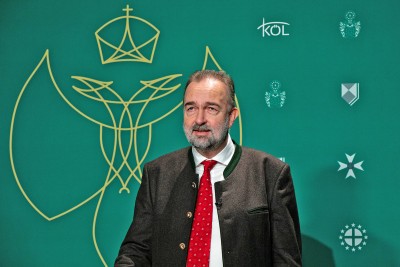Unveiling of the Habsburg Jewelry Treasure Raises Legal Questions
The recently discovered Habsburg jewel treasure, including the legendary 137-carat Florentine Diamond, is not only causing a stir in aristocratic circles but also heated debates about ownership. For the emperor's grandson Karl Habsburg, the case is clear: it is “quite clearly the private property” of the family.
 Inconsistencies are evident in the narrative shared by Karl Habsburg, the emperor's grandson, regarding the jewels once decreed by his grandmother Zita. / Picture: © Matthias Dolenc
Inconsistencies are evident in the narrative shared by Karl Habsburg, the emperor's grandson, regarding the jewels once decreed by his grandmother Zita. / Picture: © Matthias Dolenc
However, the Republic of Austria is contesting this. Vice-Chancellor Andreas Babler (SPÖ) has already announced that the Financial Procurator's Office will immediately investigate whether the jewel belongs to the Republic. If this is the case, he will initiate proceedings to recover it, as reported by News.at.
At the heart of the legal dispute is the definition of “private property” in the context of the former “supreme imperial house.” In her research for her book “Die verschollenen Schätze der Habsburger” (The Lost Treasures of the Habsburgs), Vienna expert and bestselling author Katrin Unterreiner warns that jewels classified as private property of the imperial family were not necessarily privately owned by the family, but were subject to the institution, and could therefore potentially have become the property of the Republic.
In an interview with Armin Wolf on ZIB2, Karl Habsburg refers to an expert opinion, as reported by Profil, which classifies the pieces as the private property of the emperor. However, Armin Wolf pointed out that no historian shares his view. The Habsburg Law of 1919, which declared most of the imperial property to be state property, is also relevant to the debate.
The myth of the impoverished family
The affair surrounding the jewelry treasure also sheds new light on the family's luxurious exile, as reported by Der Profil. During her research, Katrin Unterreiner came across a newspaper report in the “Neues Wiener Journal” from Christmas Day 1926. This report describes the family's lifestyle in Lekeitio (Basque Country) and refutes the myth that the exiled imperial family had to “live in poverty.” The children rode horses or traveled in the bus given to them by the Spanish king, and there were multi-course meals, although only soup was served as the first course.
As expected, left-wing newspapers reacted sarcastically to these reports at the time. The Tagblatt commented: “The starving Habsburg family. It is well known that Mrs. Zita Habsburg and her family have been living in poverty in Lequeito for years. That is what the monarchist press reports say, and apparently, there are still fools who take this fairy tale at face value.”
Florentine, Sisi's crown, and the unanswered questions
The jewels that turned up in a leather bag in Canada are to remain a secret for 100 years, as Empress Zita once decreed. Now that this period has expired, a tug-of-war over their ownership has broken out.
While part of the treasure has been found, the fate of the other treasures remains uncertain. For example, the diamond crown that Empress Sisi borrowed from the treasury for her coronation as Queen of Hungary is missing. There is suspicion that this cultural asset was “sold off piece by piece.” The legal review of the ownership of the treasure, which was declared as family jewelry rather than crown jewels, is expected to be lengthy and complex.



